#Platonic Solids
Explore tagged Tumblr posts
Text

Today I learned that the ancient Greeks associated each Platonic solid with one of the five elements.
148 notes
·
View notes
Text

I attemped to make a Platonic solid from cheese puffs. No, there was no real plan to this.
#my little pony#g4#food#cheese puffs#i can't even remember which solid i was trying to make#platonic solids
184 notes
·
View notes
Text

“It is through geometry that one purifies the eye of the soul.” ~ Plato
#sacred geometry#flower of life#magic#spiritual awakening#light#consciousness#ascension#energy#alchemy#geometry#art#photography#plato#platonic solids#philosophy#greek gods
104 notes
·
View notes
Text

my cuubes:)
#cube#cubes#block#blocks#3d#3 dimensional#rubiks cube#polyhedron#polyhedrons#convex polyhedron#regular hexahedron#minecraft#platonic solid#platonic solids#square parallelepiped#equilateral cuboid#right rhombohedron#3 zonohedron#postmuck#irl
48 notes
·
View notes
Photo
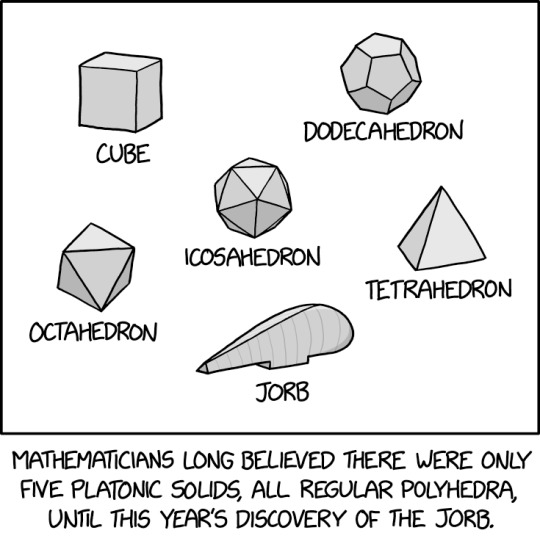
Plato made the solids, and five were gifted to the mathematicians. But in secret Plato forged a sixth solid to rule over all the others.
The Six Platonic Solids [Explained]
905 notes
·
View notes
Text

HrmMmM Platonic Solids do be platonicky
#art study#symmetry and perspective my beloathed#platonic solids#shapes#polygon#sketch#illustration#my art#art
28 notes
·
View notes
Text
Regular-ish Convex Polyhedra Bracket — Round 5 (Finals)


Propaganda
Truncated Icosidodecahedron:
Also called the Rhombitruncated Icosidodecahedron, Great Rhombicosidodecahedron, Omnitruncated Dodecahedron, Omnituncated Icosahedron
Archimedean Solid
Semiregular
Dual of the Disdyakis Triacontahedron
It has 12 regular decagonal faces, 20 regular hexagonal faces, 30 square faces, 180 edges, and 120 vertices.
It has the most edges and vertices of all platonic and archimedean solids.
Of the vertex-transitive polyhedra, it fills up the most of the volume of the sphere it fits in (89.80%).
It is not actually the shape you get when you truncate an icosidodecahedron, although it is topologically equivalent.
It is the mod's favorite three-dimensional shape.
They made a void truncated icosidodecahedron and it's glorious. I had one for a while, it's hard to turn because of alignment issues, especially the decagonal sides. Fun puzzle tho, never did figure out how to permute the last layer...
Image Credit: @anonymous-leemur
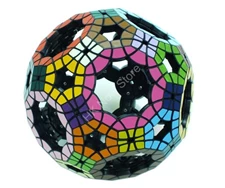
Regular Icosahedron:
Platonic Solid
Regular
Dual of the Regular Dodecahedron
It has 20 regular triangular faces, 30 edges, and 12 vertices.
Image Credit: @etirabys
#Round 5#Truncated Icosidodecahedron#Great Rhombicosidodecahedron#Regular Icosahedron#Icosahedron#Polyhedra#Archimedean Solids#Platonic Solids
120 notes
·
View notes
Text
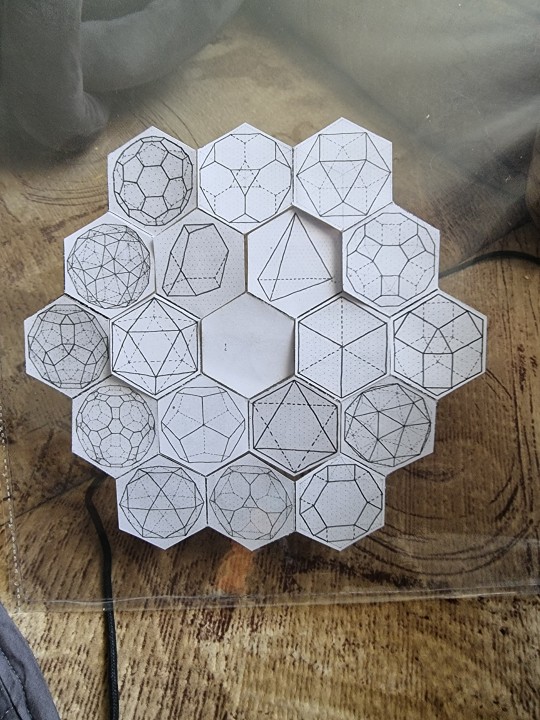
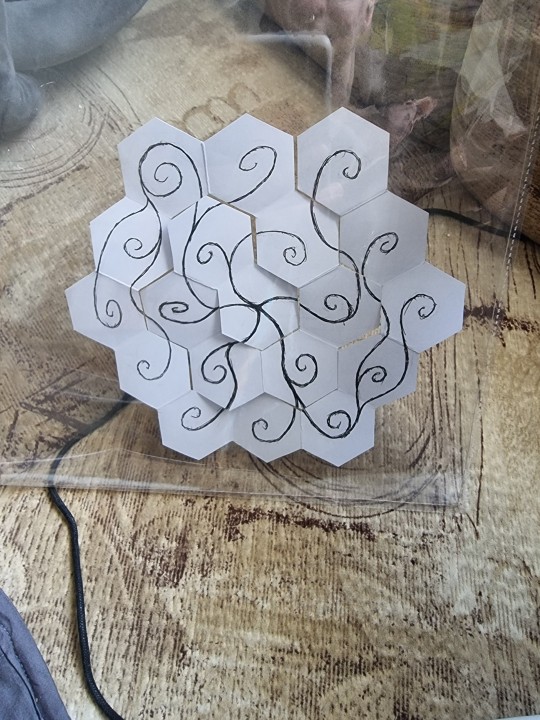
Front: 5 platonic solids and the 13 Archimedean solids
Back: Root-like structures, depicting some relationships between these 18 solids.
Both simultaneously (Holding it against light source):
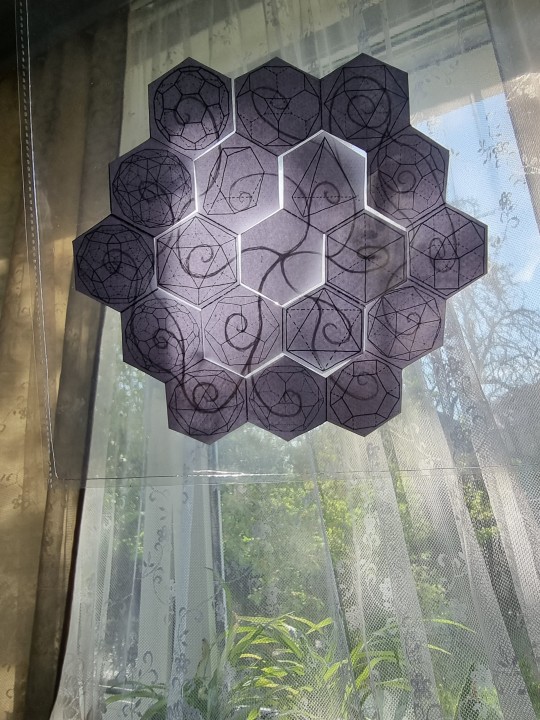
#platonic solids#archimedean solids#geometry#geometric#solids#shapes#shape soup#polyhedra#polyhedron#shape#hexagon#hexagonal#hexagons#hexagonal book#interactive art#knottys math#math art
81 notes
·
View notes
Text
Tetrahedron (oc)

She is Tetrahedron. In the research center she works at, she is the one who focuses on human sciences the most, while all her peers try to figure out how math and the shape-body works, she is keen on finding out how society works. And more than that: How would other societies different from ours work...?
concept art / A-posed model


#oc#my art#3d#oc art#blender#from 2d to 3d#animation#platonic solids#𝐿𝑒 𝓅𝓇𝑜𝒿𝑒𝒸𝓉#tetrahedron#pyramid#triangle base pyramid#shapes#solids#geometry#math#mathblr
8 notes
·
View notes
Text



✧ What Are the Platonic Solids?
The Foundations of Sacred Geometry
Platonic Solids are among the most revered and significant shapes. These five perfect polyhedra not only serve as the building blocks for understanding the geometric framework of the universe but also embody deep metaphysical principles that link the material and spiritual worlds. Known to philosophers, mathematicians, and mystics alike, these solids symbolize a profound connection between form, function, and the very fabric of existence.
What are the Platonic Solids?
A Platonic Solid is a three-dimensional shape that exhibits two defining characteristics:
Identical Faces: All faces of the shape are congruent, regular polygons.
Identical Angles and Edges: All the edges and angles of the polygons are equal.
In addition to this geometrical perfection, Platonic Solids share the remarkable trait that the same number of faces meet at each vertex. The harmony between these properties makes them unique, and only five solids meet these criteria. These five solids are:
Tetrahedron – 4 triangular faces
Cube (Hexahedron) – 6 square faces
Octahedron – 8 triangular faces
Dodecahedron – 12 pentagonal faces
Icosahedron – 20 triangular faces
The Role of the Platonic Solids in the Cosmos
These solids are not only geometrically important but were also infused with profound symbolism by ancient thinkers. The most significant influence comes from Plato, the Greek philosopher who first associated these shapes with the classical elements of Earth, Water, Air, Fire, and Aether. In his dialogue Timaeus, Plato posits that the elements of the physical world are composed of these perfect shapes, each associated with a different fundamental force or substance. Plato’s integration of geometry and cosmology would have far-reaching effects on subsequent philosophical and spiritual systems.
The Platonic Solids and their elemental associations are:
Tetrahedron – Fire
Cube (Hexahedron) – Earth
Octahedron – Air
Dodecahedron – Aether (Spirit)
Icosahedron – Water
Plato believed that these shapes represented the foundational substances from which all physical reality is derived. According to him, the Tetrahedron’s sharp edges were suited to represent Fire, the Cube’s stability mirrored the solid, grounded nature of Earth, and the Icosahedron’s fluidity corresponded to Water. The Octahedron, with its balanced symmetry, represented the breath of life, Air, while the Dodecahedron, with its celestial geometry, symbolized the etheric substance that filled the heavens.
Beyond Plato: The Platonic Solids in Ancient Mysticism
While Plato may have first outlined the connections between the Platonic Solids and the elements, the belief in their metaphysical properties goes back much further. The Pythagoreans, a religious and philosophical school that preceded Plato, already recognized the mystical importance of geometry and numbers in the divine order. The Pythagoreans believed that mathematics and geometry were not just tools for understanding the physical world but were the very means by which the cosmos expressed harmony and order.
The Platonic Solids also had an important role in alchemy, theosophy, and other esoteric systems. Alchemists used these shapes in their pursuit of transmutation and spiritual transformation, believing that by understanding the geometry of the elements, they could unlock hidden truths about the soul and the universe. For example, the Dodecahedron, often referred to as the "heavenly" shape, was associated with the fifth element—the Aether—and was believed to be the shape that structured the cosmos. It was the geometric representation of the heavens themselves, the divine ether from which all things emanated.
In the context of Kabbalah, the Platonic Solids are also integrated into the teachings of sacred geometry. The Tree of Life, which serves as the primary symbol in Kabbalistic teachings, can be thought of as a geometric model composed of spheres, lines, and, notably, polyhedral shapes that mirror the Platonic Solids. These solids reflect the interaction between the spiritual and material worlds, with each solid representing a particular level of consciousness or divine emanation.
The Platonic Solids as "Sacred" Geometry
The term Sacred Geometry refers to the use of geometric shapes and proportions to symbolize spiritual truths. The Platonic Solids are considered "sacred" because of their mathematical perfection and their association with cosmic principles. In a world full of imperfect, irregular forms, the Platonic Solids stand as idealized representations of divine order.
These shapes are also seen as fundamental archetypes that govern the physical and metaphysical realms. The belief that all matter and energy are derived from geometric patterns or forms is deeply rooted in many mystical and philosophical traditions. Modern-day spiritual practitioners continue to use the Platonic Solids in meditation, visualizations, and other metaphysical practices to align with divine proportions and cultivate harmony.
Why Are These Shapes So Important?
The symmetry and mathematical precision of the Platonic Solids point to an underlying principle of cosmic order. They represent the divine blueprint that structures the universe, offering a glimpse into how geometry reflects the divine laws that govern creation. The fact that these shapes are perfectly balanced—with equal faces, edges, and angles—symbolizes harmony and unity.
Moreover, each Platonic Solid corresponds to different aspects of human experience. For example, the Cube reflects the grounded and material aspects of existence, while the Icosahedron reflects the fluidity and adaptability of the emotional world. The Dodecahedron, as the most complex and spiritually significant, represents the connection between the physical and spiritual realms.
By studying the Platonic Solids, one begins to understand how the physical world and spiritual principles intertwine, making them essential for anyone interested in sacred geometry and its relationship to universal laws.
#sacred geometry#studyblr#platonic solids#geometry#math#esoteric#cosmic#metaphysics#metaphysical#occult#wisdom#light codes#hidden knowledge#sacred art#library of the forgotten#higher consciousness#frequency#esoterist
8 notes
·
View notes
Text

Wednesday at the Perspective Room.
#art#surreal space#dreamy#dreams#dreamy space#archviz#render#3d model#3d artwork#geometry#digital art#visual arts#visualization#vredeman de vries#floating bubbles#platonic solids#floating platonic solids#gravity#antigravity#science fiction#sci fi art#space art#metaverse#imagination#memory#design
9 notes
·
View notes
Text
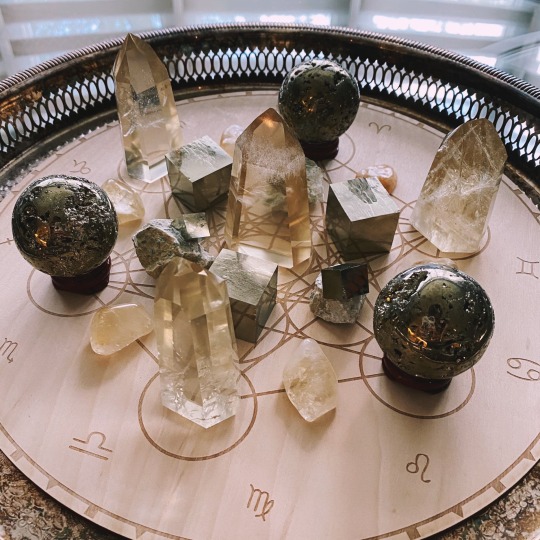
🌞 abundance & prosperity 🌞
#crystal grid#crystal grids#citrine#pyrite#crystals#crystal#crystal healing#crystal gems#crystalcore#crystal collection#healing crystals#metaphysical#chakras#sacred geometry#flower of life#metatrons cube#platonic solids#zodiac#zodiac signs#crystal tower#crystal ball
79 notes
·
View notes
Text
once on this app i saw someone call kepler-poinsot polyhedra queerplatonic solids and that post occupies a significant amount of space in my brain. i think about it daily.
118 notes
·
View notes
Text

42 notes
·
View notes
Text
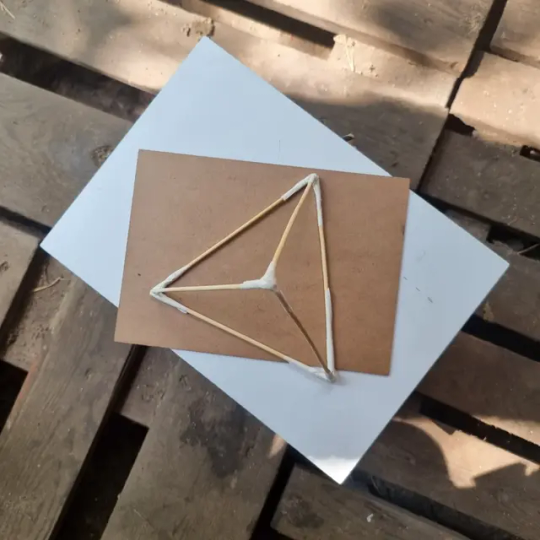
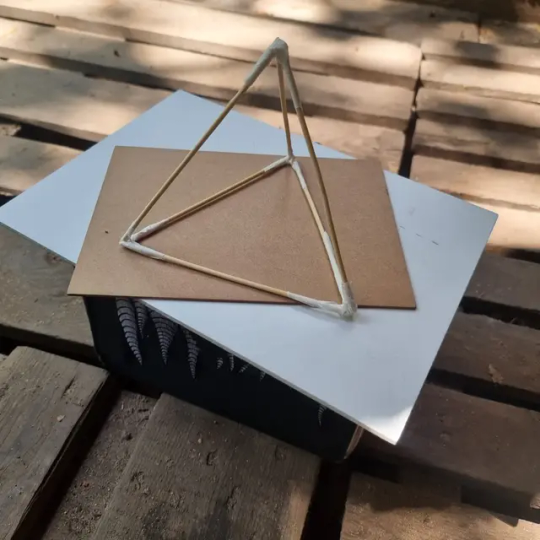

Today's Tiny Tetrahedron
(artist of the colorful artwork in the background of the first photo is unknown)
#tetrahedron#tetrahedra#platonic solid#platonic solids#polyhedra#polyhedron#geometry#mathy stuffy#art#math art#mathy art#crafts#my crafts#crafty#living in cubes....#no wait...#living in platonic solids#tetrahome#tetrahedra-octahedra honeycomb#space filling
100 notes
·
View notes